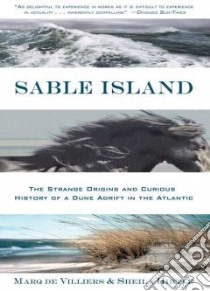Sable Island - 9780802777409
Un libro in lingua di Villiers Marq De Sheila Hirtle edito da St Martins Pr, 2006
- € 11.00
- Il prezzo è variabile in funzione del cambio della valuta d’origine
Marq de Villiers and Sheila Hirtle are coauthors of Sahara: The Extraordinary History of the World's Largest Desert and several other books on exploration, history, politics, and travel. Sable Island, published in Canada as A Dune Shift, won the twenty-eighth Evelyn Richardson Nonfiction Prize, the longest-running writing award in Canada. De Villiers and Hirtle live in Eagle Head, Nova Scotia.
Sable Island—one hundred mile due east of Nova Scotia, in the midst of the worst weather in the North Atlantic—is a thirty-mile-long sand dune, uninhabited except by a couple of government agents and by bands of wild horses that have populated the island for more than two hundred years. Yet this small place illuminates grand and global themes, both human and natural.
For centuries, Sable terrorized legions of mariners crossing from Europe to America—more than five hundred ships have been wrecked on its shores, fully ten disasters for every mile of coastline. Sable is constantly moving, its beaches disappearing and reappearing in storms, its very body in slow motion to the east. Because of this, it is a metaphor for the way the planet governs itself, because to appreciate Sable is to understand the workings of the great ocean currents, the winds and the North Atlantic gale, and the forces of entropy.
"As delightful to experience in words as it is difficult to experience in actuality . . . inherently compelling."—Chicago Sun-Times
"As delightful to experience in words as it is difficult to experience in actuality . . . inherently compelling."—Chicago Sun-Times
"[A] sense of wonder . . . prevails from first page to last . . . A great book."—Portland Press Herald (Maine)
"The longtime Canadian collaborators outline the natural and chronological history of a 30-mile crescent of peach-colored sand that still eats an occasional ship for supper. Dotted with greenery and wild horses, orchids and Ipswich sparrows, Sable Island is considered one of the great graveyards of the North Atlantic. It sits out there in the ocean's steel-gray roil on the edge of the continental shelf. Who would ever suspect that there would be a shape-shifting island in this vastness, with submerged bars ready to trap and topple a ship? Very few, at least at first, explain the authors in their glinting profile. The island's distant past is as foggy as its summer weather; Basque sailors may have been there, maybe Vikings, perhaps an Irish monk in a coracle. De Villiers and Hirtle provide a sweet little geological history of the place, a child of glacial retreat, and detail the island's special location 'in the center of this vortex, this complex system of currents, gyres, and rings' that give it stability but also may spell its doom by pushing it into the abyssal gully to the east. For such a small scrap of sand, the island has a dogged human history, borne of the rivalry between the French and English. A humane establishment was founded there to aid shipwrecked sailors (brought to life with excerpts from letters, diaries, and news reports) as well as to dump a lunatic or misfit or two. Access is guarded these days to protect the fragile estate and its inhabitants—seals that serve as fodder for the elusive Greenland shark, birds, and feral ponies—but the island remains under threat from energy interests and from nature itself. Another finely etched portrait of a strange, romantic place from this accomplished duo."—Kirkus Reviews
"Sable Island is a low-lying, 30-mile-long sand dune on the edge of the North American continental shelf southeast of Nova Scotia. It lies right in the middle of a complex set of ocean currents, meteorological systems, and historical events. It is also the subject of this well-written, easy-to-read 'biography' by de Villiers and Hirtle. Basque fishermen and Vikings were probably the first to see the island, which was later inhabited by feral horses that have survived there for almost 250 years. The authors also examine the politics of trying to preserve this fragile ecosystem . . . readers wanting to delve more deeply into the various aspects of Sable will make good use of the extensive bibliography."—Margaret Rioux, Library Journal
"This engaging natural history celebrates one of the world's most precarious landscapes, a sand spit 30 miles long and less than a mile wide, plunked down 100 miles from the Canadian coast. Continually gouged by wind and wave and stingily replenished with sand by the currents swirling around it, the evanescent but intractable island has wrecked hundreds of ships over the centuries while sheltering enough greenery and fresh water to maintain a herd of wild horses. De Villiers and Hirtle explore the geological and oceanographic forces that shaped and maintain the island and the flora and fauna that cling to it. They also examine its place in human history, regaling readers with tales of the shipwreck tragedies that darken its past and recalling the many odd little communities of castaways, lifeguards and scientists that have washed up on its beaches. The island and its environs are now threatened by oil and gas drilling, rising sea levels and an ominous drift toward the continental shelf and the deep-sea abyss beyond. But while it lasts, a dynamic equilibrium fleetingly perched atop titanic forces of nature, the island is an apt metaphor for life itself."—Publishers Weekly
Informazioni bibliografiche
- Titolo del Libro in lingua: Sable Island
- Sottotitolo: The Strange Origins And Curious History of a Dune Adrift in the Atlantic
- Lingua: English
- Autori : Villiers Marq De Sheila Hirtle
- Editore: St Martins Pr
- Collana: St Martins Pr (Paperback)
- Data di Pubblicazione: 07 Febbraio '06
- Genere: NATURE
- Argomenti : Natural history Nova Scotia Sable Island
- Pagine: 276
- Dimensioni mm: 215 x 139 x 25
- ISBN-10: 0802777406
- EAN-13: 9780802777409


